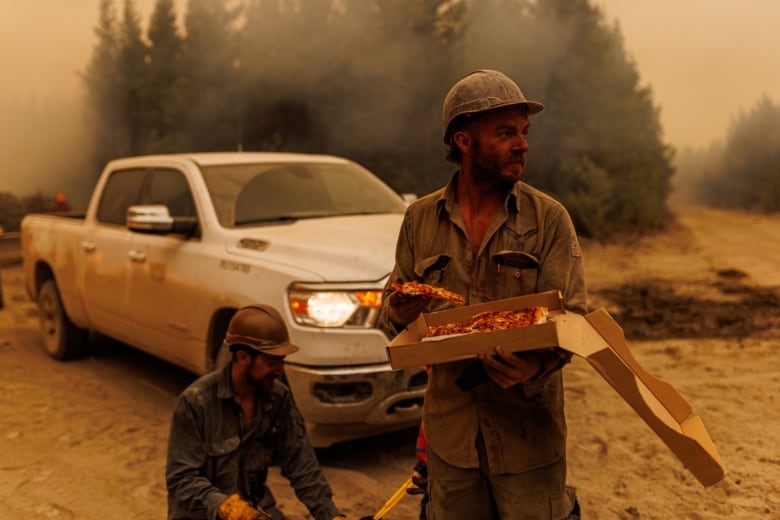The British Columbia government says military support is arriving for deployment after it asked for Ottawa’s help in fighting close to 380 wildfires burning across the province.
B.C.’s Ministry of Emergency Management says two Canadian Armed Forces reconnaissance teams were being deployed on Sunday, including a “land force team” headed for Prince George and an air force team bound for Kamloops.
A statement from the ministry says the teams are conducting assessments that will inform deployment plans for additional federal resources.
It says a working group with members of Public Safety Canada, the military and B.C. emergency management and wildfire officials are also set to meet Monday.
With around 380 wildfires burning in B.C., the Canadian Interagency Forest Fire Centre says the province has the most blazes of anywhere in Canada.
And the number of highly visible, threatening or potentially damaging “wildfires of note” has ticked up to 23 from 20 on Saturday, and there were more than 70 wildfire-related evacuation alerts or orders on Sunday, with many clustered in several regions of B.C.’s central Interior.
The Cariboo Regional District issued an evacuation order issued Friday spanning nearly 3,340 square kilometres in the Lhoosk’uz area, west of Quesnel, as well as several others in the region.
The Regional District of Bulkley-Nechako, meanwhile, says an evacuation order issued June 30 in response to the Big Creek wildfire has been rescinded and residents of a remote area that includes Omineca Provincial Park may return home, although they remain subject to an alert and must be ready to leave right away.
The district’s chair Mark Parker says some cloud cover and heavy smoke has helped responses to the region’s multiple blazes, which have prompted 11 evacuation orders and 13 alerts as of 3 p.m. Sunday.
“The last three or four days we’ve been really smoked in,” he told CBC News. “The one advantage of the smoke is that it’s helped them build some containment lines a bit closer to the fires, because the fire activity is reduced.”

He hopes the progress made in recent days can help as thunderstorms are forecasted in the region Sunday afternoon.
“We’ve got fires stretched right across our district, north, south, east, west. We need a break from that and we need that lightning to stop,” he said.
“Any moisture is welcome moisture right now, especially if it’ll come without lightning.”
Some international firefighters are also arriving soon to help local crews, Parker added.
Environment Canada is warning of two severe thunderstorms near the region’s borders with the Regional District of Fraser-Fort George and Cariboo Regional District on Sunday, which could cause hail the size of golf balls, strong winds and flash floods from “torrential” rain.
One storm could cross Highway 97 between Prince George and Hixton before 6 p.m. PT and another is southeast of McLeod Lake.
<a href=”https://twitter.com/hashtag/WildfireSmoke?src=hash&ref_src=twsrc%5Etfw”>#WildfireSmoke</a> can be a serious risk to health, particularly for children, seniors and those with heart or lung disease. Use the <a href=”https://twitter.com/hashtag/AirQuality?src=hash&ref_src=twsrc%5Etfw”>#AirQuality</a> Health Index to find out if you are at risk: <a href=”https://t.co/K1Uuioq5pv”>https://t.co/K1Uuioq5pv</a> <a href=”https://t.co/0nRcuSFWYR”>pic.twitter.com/0nRcuSFWYR</a>
—@environmentca
Residents of the area are urged to stay indoors if they hear thunder or see lightning.
“Heavy downpours can cause flash floods and water pooling on roads. Very large hail can damage property, break windows, dent vehicles and cause serious injury,” reads the warning.
The forecaster continues to warn of smoky skies and reduced visibility throughout central and eastern B.C. from the Yukon boundary to the Kootenays.
The Peace River Regional District in the province’s northeast has also cancelled an evacuation alert covering 60 properties due to the Donnie Creek blaze, the largest in B.C.’s history.
The alert had covered a lengthy stretch of Highway 97 and properties in a remote area north of Fort St. John for more than two weeks.

Drought conditions in many parts of B.C.
B.C.’s drought bulletin shows widespread drought conditions, and fire danger rating is ranked at high to extreme across much of the province.
Four of the 34 basins the province monitors are ranked at the most severe level of drought, meaning adverse impacts are almost certain. That includes all of Vancouver Island, the Bulkley-Lakes basin and the Fort Nelson basin.
The Transportation Ministry has warned drivers not to pull over and stop to take pictures of wildfires, saying it’s “very unsafe” to do so.
A statement posted to Facebook says ministry staff have heard reports of people stopping along highways, especially Highway 16 between Prince Rupert and Prince George, a route where several key blazes are burning nearby.





More Stories
Fair share: the right office solution can take finding the right partner
Ontario faces crew shortages, aircraft issues in fight against wildfires | Globalnews.ca
Refugee attends open house at Downtown Eastside affordable housing facility – BC | Globalnews.ca